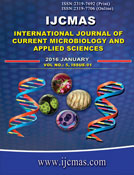


 National Academy of Agricultural Sciences (NAAS)
National Academy of Agricultural Sciences (NAAS)

|
PRINT ISSN : 2319-7692
Online ISSN : 2319-7706 Issues : 12 per year Publisher : Excellent Publishers Email : editorijcmas@gmail.com / submit@ijcmas.com Editor-in-chief: Dr.M.Prakash Index Copernicus ICV 2018: 95.39 NAAS RATING 2020: 5.38 |
The predominant microbial strains distributed in the clean rooms of sterility test facility at NIB were screened and minimum inhibitory concentration (MIC) and Minimum Bactericidal Concentration (MBC) of routinely used disinfectants coded as A, B, C, D against the isolated microbial strains were determined by broth dilution method. Routinely used test disinfectants were standardized by Rideal Walker Co-efficient (RWC) method using phenol as a standard disinfectant. Nine isolates (IN/01 to IN/09) were isolated which closely resemble to genera Staphylococcus, Micrococcus, Bacillus, Penicillium and Aspergillus in their morphological and biochemical characteristics. RWC of disinfectant A was found higher than all other disinfectants used in the study, however the disinfectant B was found effective even at a very low concentration of 0.025 x104 µg/ml against the isolated microbial strains in MIC study. Bacteria widely distributed in clean room were mainly gram positive strains. Isolates belong to the spore forming genera i.e. Bacillus, Penicillium and Aspergillus were highly resistant to the 1% disinfectant, while rest of the isolates were sensitive to all the disinfectants used in the study. Staphylococcus strains were the most sensitive followed by Micrococcus strain.
 |
 |
 |
 |
 |